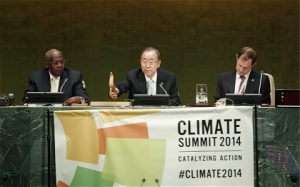Rich countries are finally coughing up cash for the Green Climate Fund, but even if the US$9.3 billion pledged so far manages to engender goodwill ahead of global climate talks in Lima in December, much more will need to be done to ensure climate finance aid is a help rather than a major hindrance to a global climate deal.
The 30 countries gathered in Berlin on Thursday pledged around US$9.3 billion for the GCF, a fund to help developing countries cut greenhouse gas emissions and adapt to climate change, so the fund is now not far short of the US$10 billion that the UN has asked for by the end of the Lima talks next month.
Considering the cupboard was bare a year ago, their promises of US$9.3 billion for the GCF got a broad welcome on Thursday. Countries can now start nominating projects, ahead of UN climate talks in Paris at the end of 2015.
“Thursday’s announcement means there is major impetus for the GCF board to make major headway between now and Paris and provide clarity about what they will invest in,” says Alex Doukas, an analyst with the World Resources Institute.
“Combined with the joint announcement from US and China last week on emissions targets, money for the climate fund is likely to help progress at Lima,” he adds.
Although developing countries had wanted donors to commit US$15 billion by the end of this year, the money committed in Berlin should limit the potential for the issue to be used an excuse for inaction in other strands of of this year’s UN climate talks that get underway at the end of November.
Ever since the Copenhagen climate summit agreed in 2009 to raise US$100 billion a year of financing a year from 2020 for carbon reduction and adaptation projects, developing nations have accused rich nations of weaselling out of their commitments, creating yet another drag on the notoriously glacial UN talks process.
But progress on climate finance could mean that poorer, but highly carbon-intensive, countries – like China and India, as well as growing economies like Vietnam and Indonesia – are more willing to discuss ambitious reduction targets of their own.
“The pledges mean that countries can visualise money in the pot for low carbon energy and projects that cut emissions, although they will want to see a lot more flowing in, particularly for adaptation,” Doukas points out.
But in some ways, persuading richer countries to finally open their wallets for the initial US$10 billion of funding may be the easiest part.
Barriers to climate finance
Total climate financing – in which the GCF is a crucial but not exclusive part – is required to scale up tenfold over the next five years if the Copenhagen promise is to be met. This will require governments to step up their contributions with additional cash and the private sector to funnel cash to adaptation schemes that might not necessarily yield the returns offered by renewable energy projects.
So far, just a sixth of climate finance has been for adaptation, while the GCF wants half of its budget to be allocated to schemes that help populations cope with the impacts of a changing climate. Encouraging investment from the private sector is increasingly urgent for governments, especially those fretting about populist opposition to foreign aid.
Fresh from victory in the mid-term elections, US Congressional Republicans have vowed to block the US$3 billion contribution pledged by President Obama this week. In the UK, the increasingly restive right wing of the governing Conservative Party wants to curb the foreign aid budget, so using public funds for overseas climate projects is likely to become increasingly unpalatable. In a sign of these sensitivities, UK Prime Minister David Cameron stressed in Berlin that the funds pledged come from existing aid budgets.The UK has been one of the stronger supporters of climate aid funds.
As data on other climate funds suggests, there is a major disparity between what is promised by politicians on one hand and delivered by the other.
The climatefundsupdate.com website estimates that US$21 billion has been pledged so far by countries, foundations and companies, but just US$3 billion of that has been ‘disbursed’ or put to work.
While some of this gap can be explained by the length of time to takes to set up the bureaucracy that can handle and then spend climate funds efficiently (and transparently) — one study attributes the shortfall to the double-counting of money that had been committed already (otherwise known as ‘non-additional’ financing), or onerous lending conditions (such as high rates of interest that rule out small-scale adaptation projects).
What’s more, critics say countries gathered in Berlin today shouldn’t really be patting themselves on the back when the sums pledged will be delivered over lengthy periods up to five years.
“The US$9.3 billion isn’t a recurring annual figure, making it even less impressive when compared against the Copenhagen promise of US $100 billion from 2020,” says Neha Rai, a senior researcher with the International Institute of Environment and Development.
A major question for policymakers is whether funds can be allocated towards climate finance that were previously used to subsidise the use of fossil fuels, as developed and developing countries aim to reform tax regimes that will reflect true market prices for climate-changing fossil fuels. “If governments manage to do this then it helps fill some of the funding gap,” says Amal-Lee Amin, who is on the private sector advisory group to the GCF.







